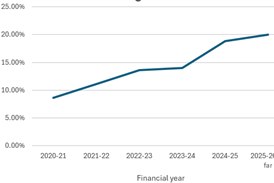The question is no longer will virtual wards work. Rather it’s about how will they work, and how well? And how can they be adopted at scale? These questions show how choosing the right partner can have a huge impact.
The NHS is at a critical point. In addition to the millions of patients languishing on waiting lists and endemic staffing shortages, the NHS is struggling to keep up with the ongoing demands of covid-19, a flu epidemic, an increase in mental health referrals, a fragile social care system, and the indirect effects of the current inflated cost-of-living. Solving these challenges lies with transforming the care model, which is why NHS England and NHS Improvement are asking all integrated care systems to extend or introduce the virtual ward model by December 2023.
Sponsored by
We know that digital-first care can tackle some of the NHS’s biggest challenges. For example, with Huma’s “hospital at home” technology clinicians have been able to almost double clinical capacity, and a peer-reviewed study reported 40 per cent shorter hospital stays when using our app for acute respiratory illness.
More recently, our award-winning work with NHS Wales showed that clinicians were able to deliver the right care, faster and more precisely. Patients were medically optimised 76 per cent faster and one health board reported that over 80 per cent of instances where patients had their care escalated as a result of data reported using the app. In such cases, patients would not have otherwise alerted anyone.*
So, the question is no longer if virtual wards will work, instead, the questions are about how to implement them successfully, and how to ensure they work at scale so that we can see benefits across the NHS. And that’s where working in partnership can have a huge impact.
Closing the gap between intention and action
The NHS could be transformed with technology, but that is only one part of the solution. We need to redesign services around the needs of patients and clinicians so we can meet the demands on health services in the future.
The NHS needs to evolve to meet the needs of an ageing population. This evolution needs to ensure we give people the support they need to stay healthy and get well sooner. We need a technology-enabled service redesign so that people can access care closer to home or at home and spend less time in hospital wards or waiting for appointments with their GP or nurse. And we need better planning and proactive remote patient monitoring so that fewer people end up needing emergency care when they could have been treated elsewhere first.
We all know this, and now with funding available, why are we not seeing greater progress? The question many ICSs and trusts are asking is “where do we start?” Without knowing how to begin, we are left with this clear gap between intention and action.
Steps for success
Here are some steps that system leaders and providers should consider taking to create new ways of working and ensure the technology has the impact we need.
- Outline the problem
A mistake that is often made is that organisations jump straight into procuring a technology solution without understanding the problem they intend to solve. Partnerships can help here. Lean on expertise from those with industry experience who have proven, real-world evidence. It means that you are more likely to tackle the right problems, rather than reverting to another additive solution.
- Lead with clinical engagement
Engagement is key. Clinicians are and should be the champions of the project and they will dictate its success. Engagement needs to be a priority from the onset. Start by mapping your clinicians’ pathways and their current ways of working today. Everyone needs a clear understanding of where the solution will fit in the pathway, how it will be integrated and how it will benefit the patients.
- Upskill your workforce
Introducing technology is one piece of the puzzle. The workforce needs to understand its role and how to utilise technology for better results. The real benefits will not come until everyone understands the value and can use the systems confidently to ensure that there is optimal implementation.
- Look beyond initial procurement
Having technology in place does not automatically guarantee great results. Forming partnerships is key to the long-term success of projects like virtual wards. They allow us to build solutions together and solve the problems that matter. It requires a complete step change in how we approach innovation, going beyond the quick wins to see the bigger picture and longer-term benefits.
- Make transformation everybody’s business
Transformation will not happen overnight. It needs a whole ecosystem approach. The whole workforce needs to feel part of the change, culture and mindset. Orchestrating this from within can be difficult, which is where the right partnerships can help. Partners with proven solutions and real-world evidence can help guide and shape successful rollouts.
Seizing the opportunity
As an ever-increasing number of technologies and solutions become available, ICSs and trusts must keep abreast of their capabilities to make valuable use of them. They should use real-world evidence to identify which innovations will provide real value. Building strong partnerships with other organisations within and outside of the NHS is critical. It is about building an ecosystem that is solving problems together, building trust amongst each other and ultimately, achieving success together. Forming partnerships that benefit the health system, providers, and more importantly supports the patients and clinicians, will lead to success and help shift the needle.
Dr Harpreet Sood works at Huma and is a practising NHS GP.
*Data from an evaluation of a pilot to explore remote monitoring of patients with heart failure































